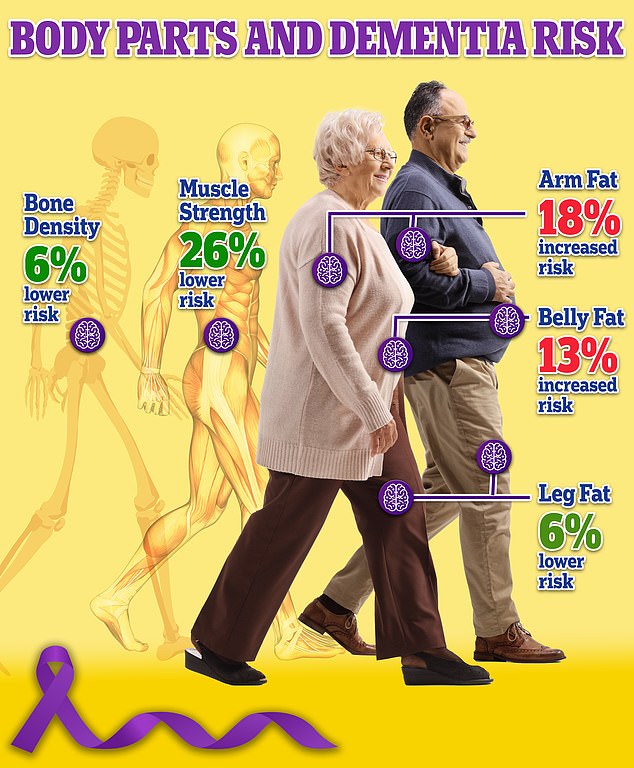Carrying extra fat around the arms or abdomen could increase the risk of Alzheimer’s and Parkinson’s diseases, a major study suggests.
Researchers have found that those who carry weight in these areas, often called “beer bellies” and “bingo wings,” appear to be at higher risk for the diseases, while people with more muscle have a lower risk.
The study involved 412,691 people, with an average age of 56, who were followed for nine years.
At the beginning of the study, body composition measurements were taken, such as waist and hip measurements, grip strength, bone density, and fat and lean mass.
During the study, 8,224 people developed neurodegenerative diseases, mainly Alzheimer’s disease, other forms of dementia and Parkinson’s disease.
After adjusting for other factors that might affect disease rates, such as high blood pressure, smoking and alcohol use, and diabetes, the researchers found that overall, people with high levels of abdominal fat were 13 percent more likely to develop these diseases than people with low levels of abdominal fat.
People with high levels of arm fat were 18 percent more likely to develop the diseases than those with low levels of arm fat.
However, those with high muscle strength were 26 percent less likely to develop diseases than those with low levels of strength.
Dr Huan Song, lead author of the study and an epidemiologist at Sichuan University in China, said: “These neurodegenerative diseases like Alzheimer’s and Parkinson’s affect more than 60 million people worldwide, and that number is expected to grow as the population ages, so it is crucial that we identify ways to modify risk factors to develop some preventative tools.”
‘This study highlights the potential to reduce people’s risk of developing these diseases by improving their body composition.
‘Targeted interventions to reduce trunk and arm fat while promoting healthy muscle development may be more effective in protecting against these diseases than general weight control.’
The link between bingo wings and belly fat and these diseases was partly explained by the occurrence of heart disease and stroke during the study, the researchers said.
“This underscores the importance of treating these cardiovascular diseases promptly to help prevent or delay the development of Alzheimer’s, Parkinson’s or other degenerative diseases,” said Professor Song.
The findings were published in the journal Neurologythe medical journal of the American Academy of Neurology.

Visceral fat surrounds the abdominal organs deep within the body, while subcutaneous fat lies beneath the skin. Even people with a healthy BMI can have a significant amount of visceral fat.

The above shows the prevalence of dementia (proportion of people suffering from dementia) by year from 2000 to 2016. It reveals a gradual decline in rates.
Abdominal fat is generally made up of subcutaneous fat and visceral fat. Subcutaneous fat is located just beneath the skin, while visceral fat surrounds vital organs such as the heart.
The researchers noted that storing fat around the hips and upper thighs “has been linked to health benefits, primarily because it may protect against ectopic fat deposition within vital organs (e.g., muscles), improve insulin sensitivity, and reduce inflammation.”
Ectopic fat accumulates inside essential organs such as the liver and heart, contributing to problems such as heart disease and fatty liver disease.
The researchers wrote: ‘Our study provides new insights by identifying significant associations between ‘predominant fat distribution in the legs’ and ‘predominant fat distribution in the arms’ patterns with neurodegeneration risk, emphasizing the pivotal role of fat and muscle distribution in predicting and potentially mitigating neurodegenerative diseases, beyond traditional weight metrics.’
There were several limitations, with the team noting most notably that participants were mostly white people from the UK and Northern Ireland, resulting in a less diverse sample size.
“Further research involving ethnically diverse cohorts is essential to confirm our findings,” the researchers wrote.

